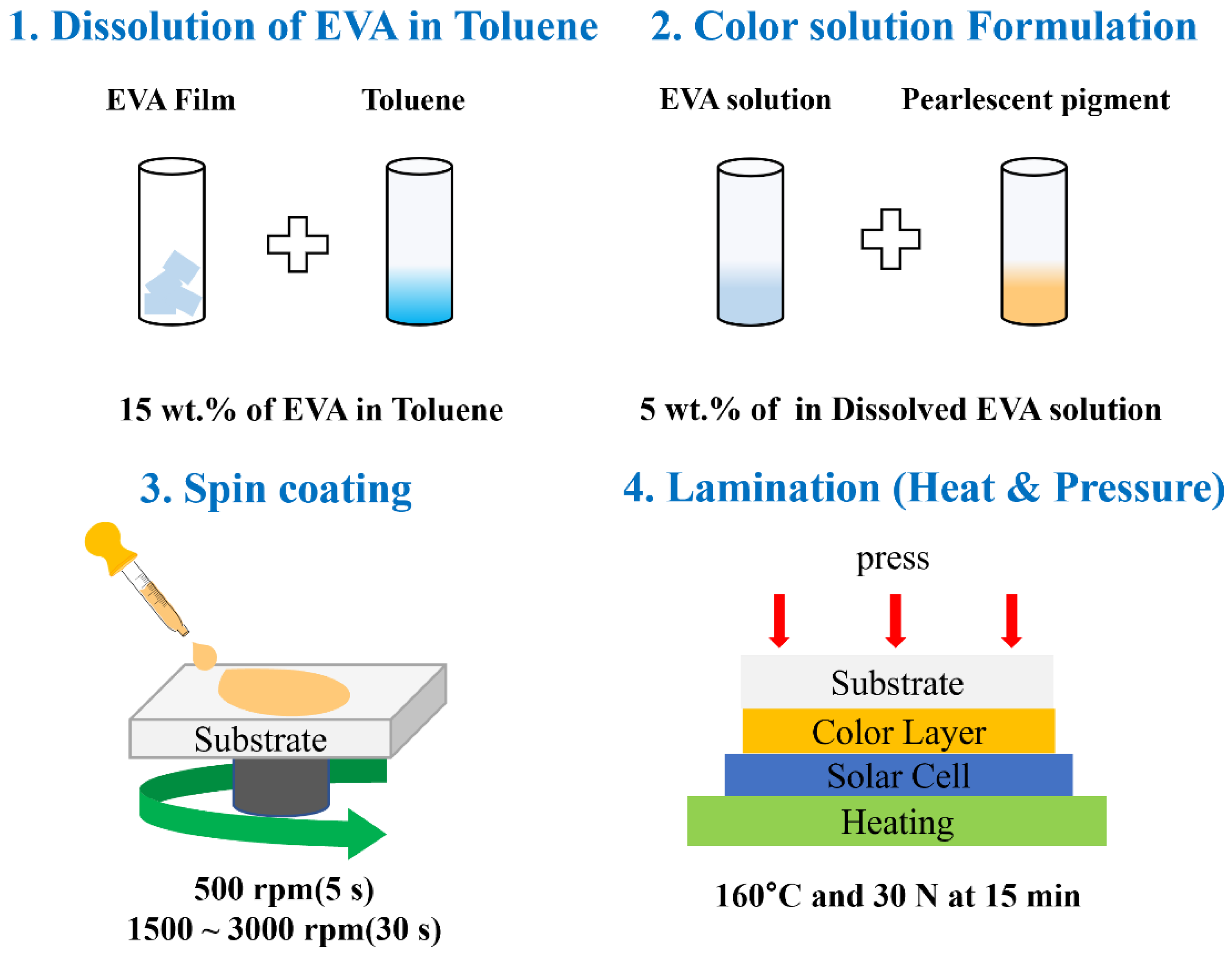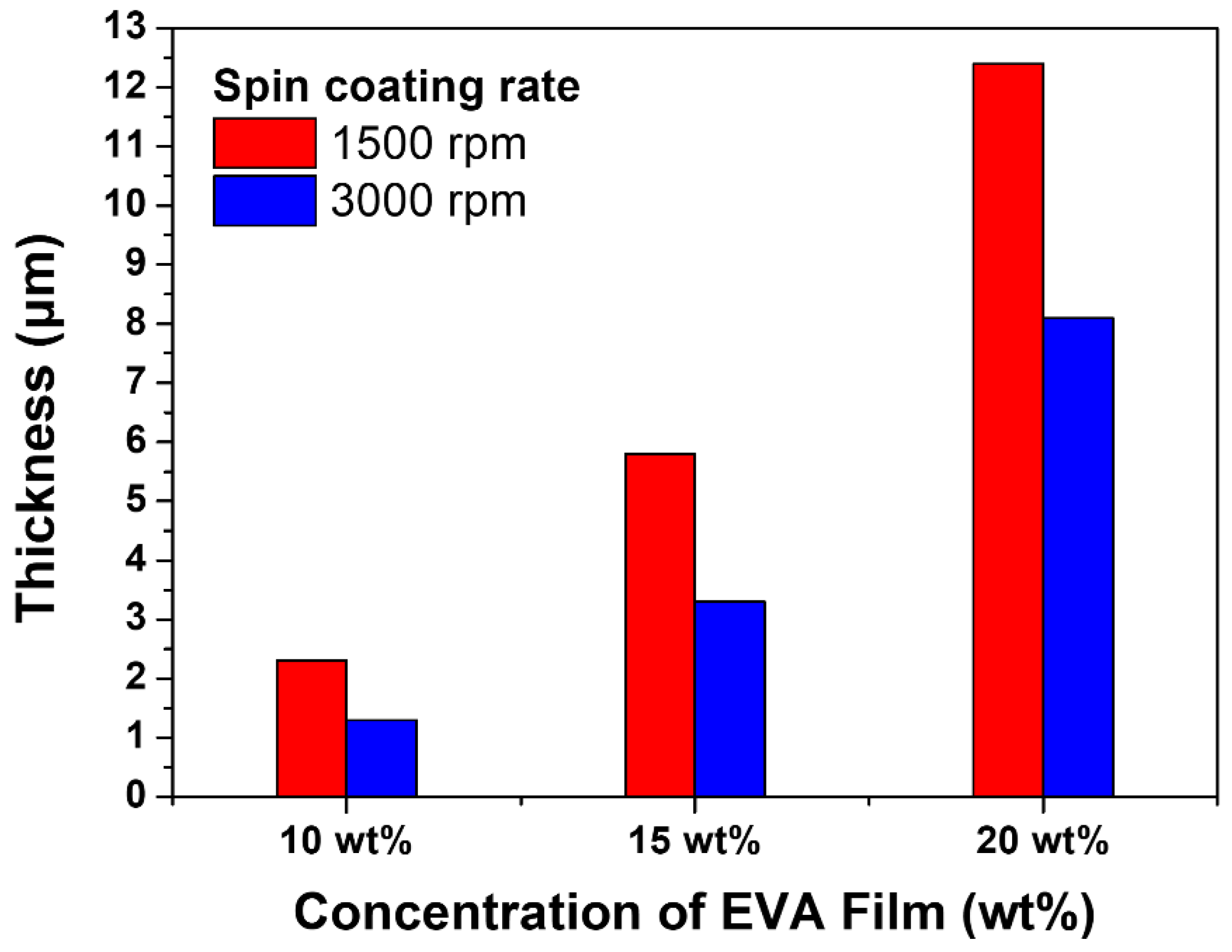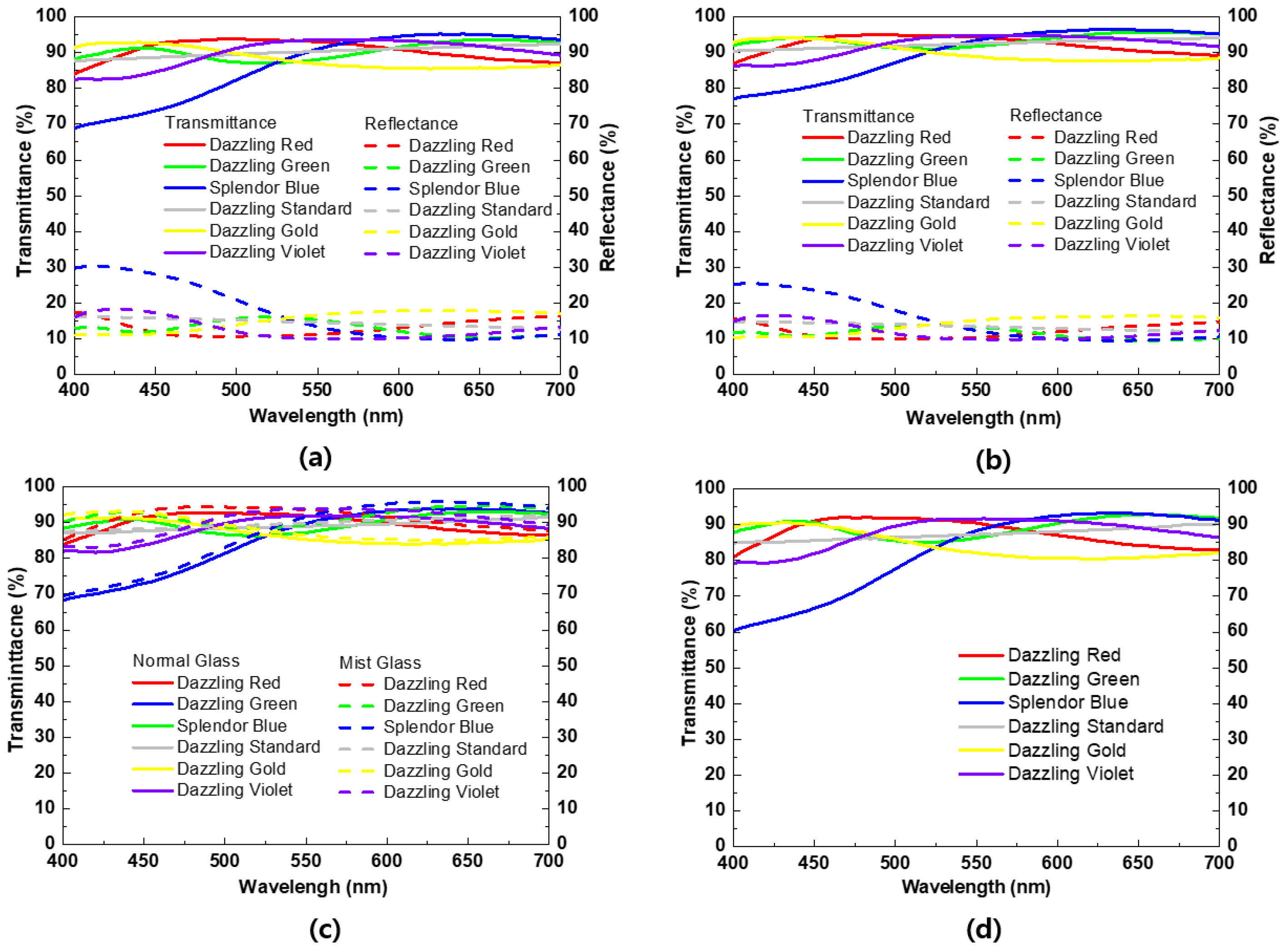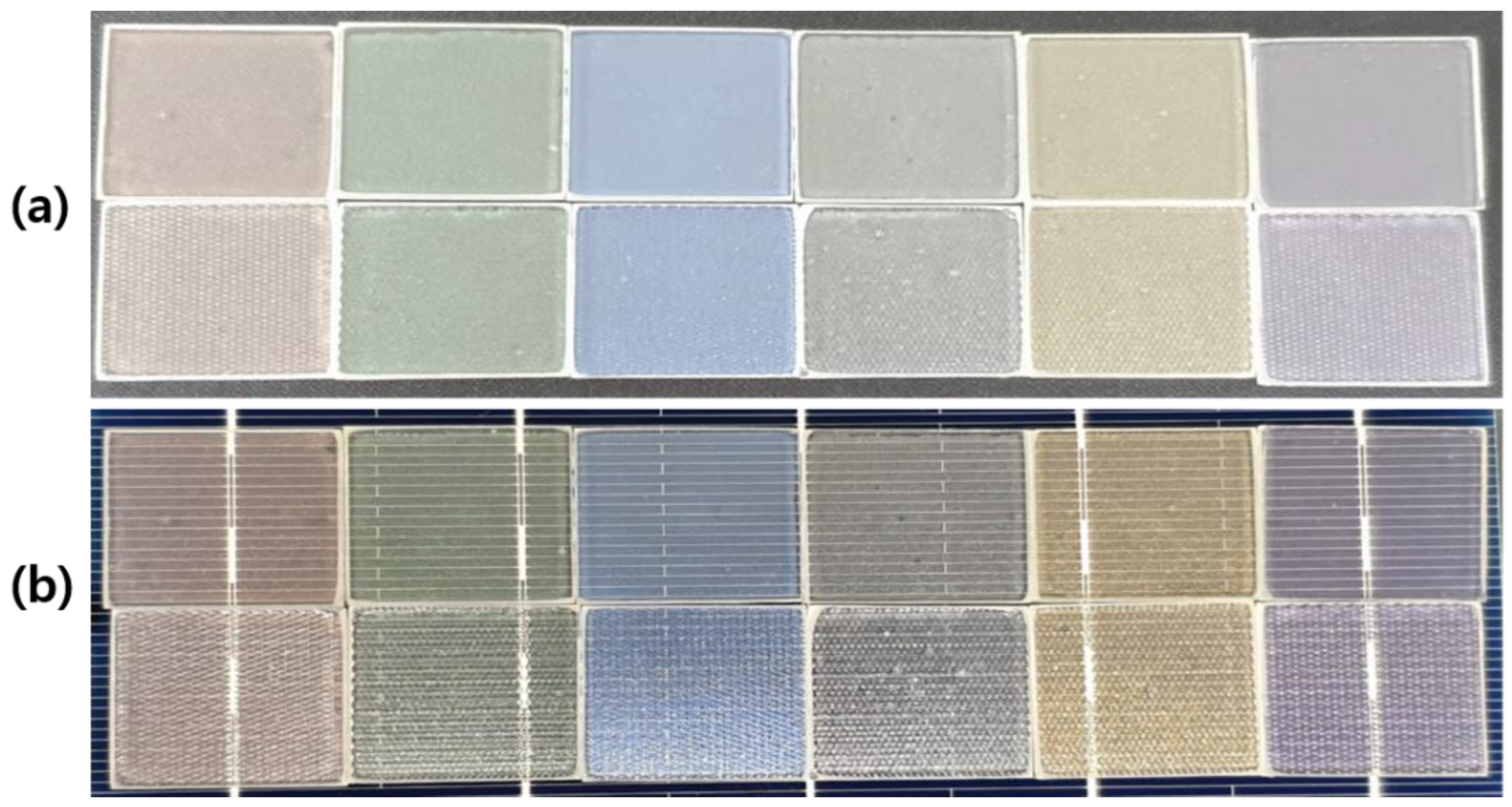Fabrication of Color Glass by Pearlescent Pigments and Dissolved EVA Film
Abstract
:1. Introduction
2. Experimental Section
2.1. Color Solution Formulation and Color Glass Fabrication Process
2.2. Lamination and Solar Efficiency Measurement Method
3. Results and Discussion
3.1. Characterization of Thin Color Film and Color Glass
3.2. Stability of the Color Glass and the Effect on Solar Power Efficiency
4. Conclusions
Supplementary Materials
Author Contributions
Funding
Institutional Review Board Statement
Informed Consent Statement
Data Availability Statement
Conflicts of Interest
References
- Ge, M.; Zhao, Y.; Xuan, Z.; Zhao, Y.; Wang, S. Experimental research on the performance of BIPV/T system with water-cooled wall. Energy Rep. 2022, 8, 454–459. [Google Scholar] [CrossRef]
- Ghosh, A. Potential of building integrated and attached/applied photovoltaic (BIPV/BAPV) for adaptive less energy-hungry building’s skin: A comprehensive review. J. Clean. Prod. 2020, 276, 123343. [Google Scholar] [CrossRef]
- Gholami, H.; Røstvik, H.N.; Müller-Eie, D. Holistic economic analysis of building integrated photovoltaics (BIPV) system: Case studies evaluation. Energy Build. 2019, 203, 109461. [Google Scholar] [CrossRef]
- Gholami, H.; Røstvik, H.N. Economic analysis of BIPV systems as a building envelope material for building skins in Europe. Energy 2020, 204, 117931. [Google Scholar] [CrossRef]
- Debbarma, M.; Sudhakar, K.; Baredar, P. Comparison of BIPV and BIPVT: A review. Resour. Technol. 2017, 3, 263–271. [Google Scholar] [CrossRef]
- Reddy, P.; Gupta, M.V.N.S.; Nundy, S.; Karthick, A.; Ghosh, A. Status of BIPV and BAPV System for Less Energy-Hungry Building in India—A Review. Appl. Sci. 2020, 10, 2337. [Google Scholar] [CrossRef]
- Amado, M.; Poggi, F. Solar Energy Integration in Urban Planning: GUUD Model. Energy Procedia 2014, 50, 277–284. [Google Scholar] [CrossRef]
- Sioshansi, F. Distributed Generation and Its Implications for the Utility Industry; Academic Press: Cambridge, MA, USA, 2014. [Google Scholar]
- Yang, Y.; Wang, Q.; Xiu, D.; Zhao, Z.; Sun, Q. A building integrated solar collector: All-ceramic solar collector. Energy Build. 2013, 62, 15–17. [Google Scholar] [CrossRef]
- Shukla, A.K.; Sudhakar, K.; Baredar, P. Recent advancement in BIPV product technologies: A review. Energy Build. 2017, 140, 188–195. [Google Scholar] [CrossRef]
- Zhang, T.; Wang, M.; Yang, H. A Review of the Energy Performance and Life-Cycle Assessment of Building-Integrated Photovoltaic (BIPV) Systems. Energies 2018, 11, 3157. [Google Scholar] [CrossRef]
- Temby, O.; Kapsis, K.; Berton, H.; Rosenbloom, D.; Gibson, G.; Athienitis, A.; Meadowcroft, J. Building-Integrated Photovoltaics: Distributed Energy Development for Urban Sustainability. Environ. Sci. Policy Sustain. Dev. 2014, 56, 4–17. [Google Scholar] [CrossRef]
- Kippelen, B.; Brédas, J.-L. Organic photovoltaics. Energy Environ. Sci. 2009, 2, 251–261. [Google Scholar] [CrossRef]
- Brabec, C.J. Organic photovoltaics: Technology and market. Sol. Energy Mater. Sol. Cells 2004, 83, 273–292. [Google Scholar] [CrossRef]
- Schüler, A.; Roecker, C.; Boudaden, J.; Oelhafen, P.; Scartezzini, J.-L. Potential of quarterwave interference stacks for colored thermal solar collectors. Sol. Energy 2005, 79, 122–130. [Google Scholar] [CrossRef]
- Mertin, S.; Caër, V.H.-L.; Joly, M.; Mack, I.; Oelhafen, P.; Scartezzini, J.-L.; Schüler, A. Reactively sputtered coatings on architectural glazing for coloured active solar thermal façades. Energy Build. 2014, 68, 764–770. [Google Scholar] [CrossRef]
- Espeche, J.M.; Noris, F.; Lennard, Z.; Challet, S.; Machado, M. PVSITES: Building-Integrated Photovoltaic Technologies and Systems for Large-Scale Market Deployment. Multidiscip. Digit. Publ. Inst. Proc. 2017, 1, 690. [Google Scholar] [CrossRef]
- Gasonoo, A.; Ahn, H.-S.; Kim, M.-H.; Lee, J.-H.; Choi, Y. Metal Oxide Multi-Layer Color Glass by Radio Frequency Magnetron Sputtering for Building Integrated Photovoltaic System. J. Korean Electr. Electron. Eng. 2018, 22, 1056–1061. [Google Scholar] [CrossRef]
- Gasonoo, A.; Ahn, H.-S.; Lim, S.; Lee, J.-H.; Choi, Y. Color Glass by Layered Nitride Films for Building Integrated Photovoltaic (BIPV) System. Crystals 2021, 11, 281. [Google Scholar] [CrossRef]
- Schueler, A.; Roecker, C.; Scartezzini, J.-L.; Boudaden, J.; Oelhafen, P. Designing thin film multilayer for colored glazed thermal collectors. Eurosun 2004, 2, 858–865. Available online: https://www.osti.gov/etdeweb/biblio/20672065 (accessed on 10 August 2022).
- Ahn, H.-S.; Gasonoo, A.; Jang, E.-J.; Kim, M.-H.; Lee, J.-H.; Choi, Y. Transition Metal Oxide Multi-Layer Color Glass for Building Integrated Photovoltaic System. J. Korean Electr. Electron. Eng. 2019, 23, 1128–1133. [Google Scholar] [CrossRef]
- Erlat, A.G.; Henry, B.M.; Grovenor, A.C.R.M.; Briggs, A.G.D.; Chater, R.J.; Tsukahara, Y. Mechanism of Water Vapor Transport through PET/AlOxNy Gas Barrier Films. J. Phys. Chem. B 2003, 108, 883–890. [Google Scholar] [CrossRef]
- Yeo, S.J.; Bera, S.; Kim, B.; Kim, D.; Lee, B.; Park, S.; Lim, H. Inorganic-Nanoparticle-Based Super-Hydrophobic Colored Coatings for Sustainable Building-Integrated Photovoltaics. Adv. Mater. Technol. 2022, 2200358. [Google Scholar] [CrossRef]
- Gasonoo, A.; Ahn, H.-S.; Jang, E.-J.; Kim, M.-H.; Gwag, J.; Lee, J.-H.; Choi, Y. Fabrication of Multi-Layer Metal Oxides Structure for Colored Glass. Materials 2021, 14, 2437. [Google Scholar] [CrossRef]
- De Oliveira, M.C.C.; Cardoso, A.S.A.D.; Viana, M.M.; Lins, V.D.F.C. The causes and effects of degradation of encapsulant ethylene vinyl acetate copolymer (EVA) in crystalline silicon photovoltaic modules: A review. Renew. Sustain. Energy Rev. 2018, 81, 2299–2317. [Google Scholar] [CrossRef]
- Ahn, H.-S.; Gasonoo, A.; Lim, S.-M.; Lee, J.-H.; Choi, Y. Fabrication of Color Glass with High Light Transmittance by Pearlescent Pigments and Optical Adhesive. Materials 2022, 15, 2627. [Google Scholar] [CrossRef]
- CQV Co., Ltd. Creation of Quality Value. Available online: https://cqv.co.kr/portfolio/ (accessed on 28 July 2022).
- NURI Corp. Available online: http://www.nuricorp.co.kr/board/board_list?code=product04 (accessed on 21 June 2022).







| EVA Amount | 5 wt.% | 10 wt.% | 15 wt.% | 20 wt.% |
|---|---|---|---|---|
| EVA 1g | X | X | O | O |
| EVA 2g | X | O | O | O |
| EVA 3g | X | O | O | O |
Publisher’s Note: MDPI stays neutral with regard to jurisdictional claims in published maps and institutional affiliations. |
© 2022 by the authors. Licensee MDPI, Basel, Switzerland. This article is an open access article distributed under the terms and conditions of the Creative Commons Attribution (CC BY) license (https://creativecommons.org/licenses/by/4.0/).
Share and Cite
Lim, S.; Ahn, H.-S.; Gasonoo, A.; Lee, J.-H.; Choi, Y. Fabrication of Color Glass by Pearlescent Pigments and Dissolved EVA Film. Materials 2022, 15, 5570. https://doi.org/10.3390/ma15165570
Lim S, Ahn H-S, Gasonoo A, Lee J-H, Choi Y. Fabrication of Color Glass by Pearlescent Pigments and Dissolved EVA Film. Materials. 2022; 15(16):5570. https://doi.org/10.3390/ma15165570
Chicago/Turabian StyleLim, Seongmin, Hyeon-Sik Ahn, Akpeko Gasonoo, Jae-Hyun Lee, and Yoonseuk Choi. 2022. "Fabrication of Color Glass by Pearlescent Pigments and Dissolved EVA Film" Materials 15, no. 16: 5570. https://doi.org/10.3390/ma15165570
APA StyleLim, S., Ahn, H.-S., Gasonoo, A., Lee, J.-H., & Choi, Y. (2022). Fabrication of Color Glass by Pearlescent Pigments and Dissolved EVA Film. Materials, 15(16), 5570. https://doi.org/10.3390/ma15165570






